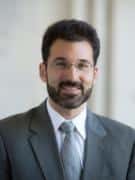
Matthew Rojansky
Director, Woodrow Wilson Center Kennan Institute
When did you first develop an interest in Slavic, East European and Eurasian Studies?
For me, it began with the study of Russia’s fascinating history, which was my undergraduate concentration at Harvard, primarily under the tutelage of Terry Martin, now Director of the Davis Center, and Eric Lohr, now at American University. That foundation informs my professional and personal perspective on contemporary Russia and US-Russia relations today. Simply put, there is no story in world history richer with human achievement in art, music, literature, science, grand geopolitics, or world exploration, than the history of Russia. Yet at the same time, hardly can you find a story with more horrible and tragic human suffering. This is a compelling and endlessly fascinating contrast, the unraveling of which is more than a life’s work for any scholar.
How have your interests changed since then?
I’m probably unusual among ASEEES members in that I did not pursue a PhD, even though I conducted quite extensive original archival research in Russia and Ukraine in support of my thesis on Khrushchev’s amnesties for Soviet citizens convicted of Nazi collaboration. I did, however, continue my education in Russian language and my work on US-Russia relations, thanks very much to several US government grant programs that have now been either eliminated or severely cut back. I completed my JD at Stanford, where I was incredibly fortunate to have fellowships both at the Center for Russian East European and Eurasian Studies (CREEES), and the Center for International Security and Cooperation (CISAC). Studying international and national security law brought me to Washington DC, where after forays into military justice and politics, I eventually discovered the wonderful world of think tanks, operating at the intersection between academic research and policy analysis. There’s no better example of that intersection than the Woodrow Wilson Center, and within it the Kennan Institute, where I now have the incredible privilege of serving as Director.
What is your current research project?
Just like an interest in Russia more generally, a passion for history is hard to shake. When I approach contemporary political and security problems in Russia and its neighborhood, I find myself consistently drawn to historical themes and challenges rooted in history. So perhaps it’s no surprise that my major research focus now is a project co-organized with Dr. Lily Gardner Feldman of Johns Hopkins to examine how lessons from Germany’s post World War II foreign policy of reconciliation with neighboring states, the Jewish community, and the wider world might be applied to help address inter- and intra-state conflict and distrust stemming from historical memory in post-Soviet Eastern Europe. The latest events in Ukraine are a powerful reminder of the urgent need to begin this type of reconciliation between Russia and its neighbors, as well as within societies in the region.
What do you value about your ASEEES membership?
ASEEES has always been a central to my involvement in the field of Slavic studies. I actually worked as an office intern for the then-AAASS when I was an undergraduate, so in a way joining as a member myself and attending the convention as a participant has felt like a homecoming. I benefit enormously from the opportunity to network with colleagues and engage with those conducting new research in my areas of interest at the annual convention. I also know that for the Kennan Institute and for Kennan alumni, ASEEES is a vital channel to maintain professional relationships, and to advertise our fellowships to ensure we continually receive the highest quality applicants.
Besides your professional work, what other interests and/or hobbies do you enjoy?
My wife Lucy (we met in Russian class, of course!) and I have been blessed with two beautiful children, Edith (2) and Abraham (4 months). In the slivers of spare time fatherhood and work permit, I try to paint. I usually try to copy the masters, and am a particular fan of Russian impressionism. Here is one example, a rather anemic replica of Levitan’s “March, 1895.” Obviously, I will not be retiring from my day job any time soon!
